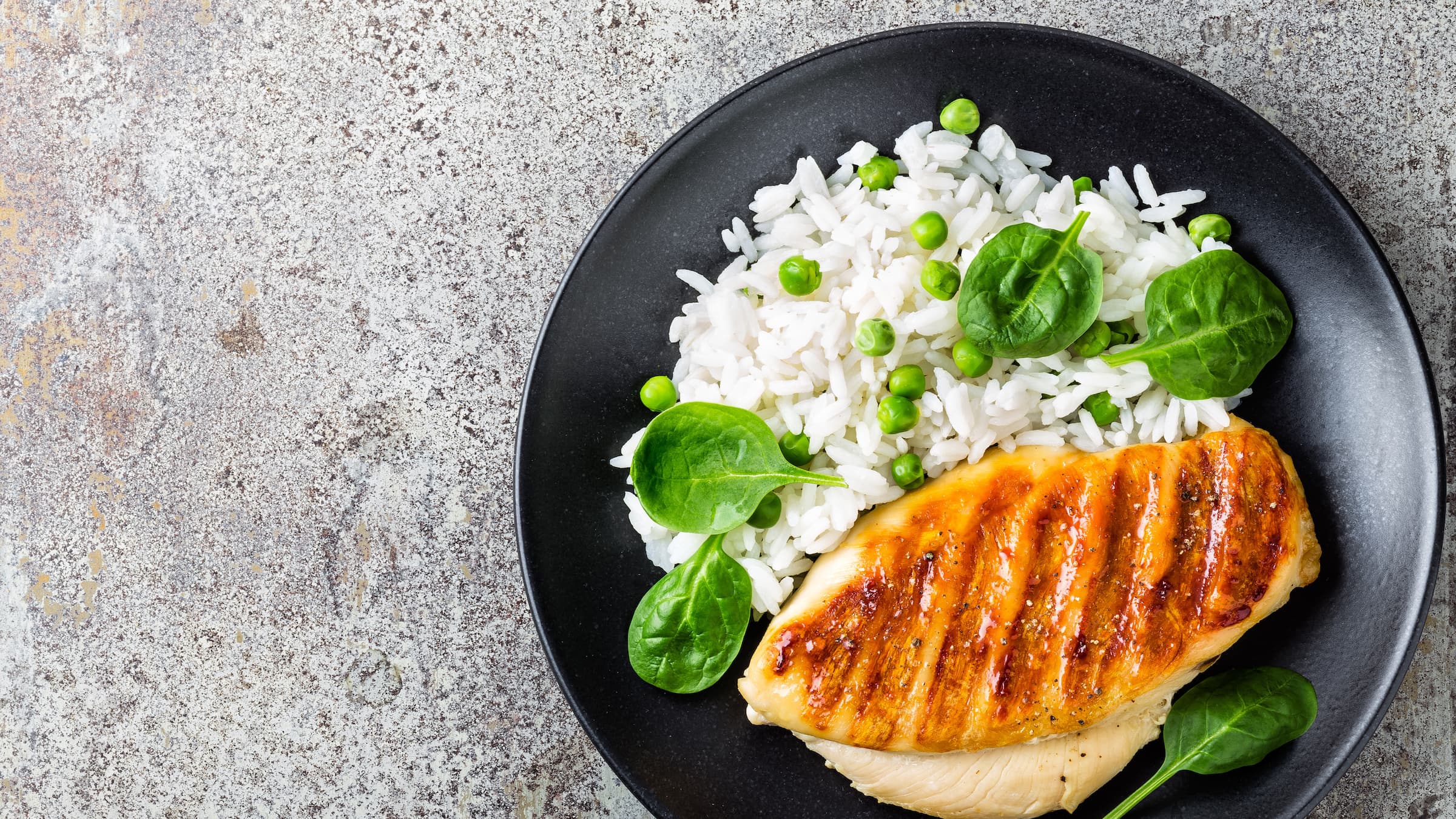Rice is more than just a comfort food—it’s a cultural staple in cuisines around the world. But when it comes to weight loss, white rice tends to spark debate. Is it helpful? Plain white rice can absolutely have a place in a balanced eating plan, especially when you pay attention to portions and pair it with protein and fiber-rich foods that can keep you full.
While it’s low in fat and easy to digest, white rice is also low in fiber and has a high glycemic index. That means it can raise your blood sugar quickly if eaten on its own, but that’s easy to offset. Adding lean protein, vegetables, or healthy fats can slow digestion and improve satiety. Plus, white rice is naturally gluten-free and often enriched with B vitamins and iron, which support energy metabolism—something that matters when you’re trying to lose weight. So if you love rice, there’s no need to cut it out. Just be smart about how you build your plate.
✅ Quick answer
Yes, white rice can help with weight loss because:
- Low in fat and calories – It provides a light source of energy without excess fat.
- Gluten-free and easily digestible – Ideal for sensitive stomachs and those with gluten intolerance.
- Enriched with essential vitamins – Fortification adds B vitamins and iron, supporting energy metabolism.
🥗 Macronutrients of white rice (per 100g/about 1/2 cup cooked)
| Nutrient | Amount | % RDA* |
|---|---|---|
| Calories | 130 kcal | 6.5% |
| Protein | 2.7 g | 5% |
| Total carbohydrates | 28.2 g | 10% |
| Dietary fiber | 0.4 g | 1% |
| Sugars | 0 g | — |
| Total fat | 0.3 g | <1% |
| Saturated fat | 0.1 g | 0.5% |
| Monounsaturated fat | 0.1 g | — |
| Polyunsaturated fat | 0.1 g | — |
| Omega-3 | 0 g | — |
| Omega-6 | 0.01 g | — |
*Recommended dietary allowance (RDA) is defined as the average daily amount of nutrients that are needed to meet the requirements of nearly all healthy people based on a 2,000-calorie diet.
Summary: White rice is a low-calorie, low-fat carbohydrate source with minimal protein and fiber, making it a light base for meals that can be enhanced with nutrient-dense additions.
💊 Vitamins & minerals in white rice (micronutrients)
| Vitamin / mineral | Amount (per 100g) | % RDA* |
|---|---|---|
| Vitamin A | 0 µg | Vitamin/mineral |
| Vitamin C | 0 mg | 0% (DV = 90 mg) |
| Vitamin B6 | 0.1 mg | 7% (DV = 1.3–1.7 mg) |
| Thiamin (B1) | 0.16 mg | 13% (DV = 1.2 mg) |
| Folate | 58 µg | 15% (DV = 400 µg) |
| Potassium | 35 mg | 1% (DV = 4,700 mg) |
| Magnesium | 12 mg | 3% (DV = 400 mg) |
| Zinc | 0.5 mg | 5% (DV = 11 mg) |
| Selenium | 7 µg | 13% (DV = 55 µg) |
*Recommended dietary allowance (RDA) is defined as the average daily amount of nutrients that are needed to meet the requirements of nearly all healthy people.
** micrograms
Summary: Although not packed with nutrients, enriched white rice provides modest amounts of B vitamins (including thiamin and folate), iron, zinc, and selenium, which support energy metabolism and overall health.
🔍 Nutrient breakdown
- Glycemic Index (GI) of white rice
✔️ Glycemic Index: 73 (High)
💡 Tip: Low-GI foods help maintain stable blood sugar and control hunger; pair white rice with fiber-rich vegetables or proteins to mitigate its high GI. - Is white rice high in protein?
✔️ No – White rice contains 2.7 g of protein per 100g.
🔹 Better protein alternatives: Chicken breast | lentils - Is white rice high in fiber?
✔️ No – It provides only 0.4 g of fiber per 100g.
💡 Tip: Enhance your meal by adding beans or leafy greens to boost fiber and increase satiety. - Is white rice low in carbs?
✔️ No – It has 28.2 g of carbohydrates per 100g.
💡 Tip: For lower-carb options, consider swapping a portion of white rice with cauliflower “rice.” - Is white rice gluten-free?
✔️ Yes – White rice is naturally gluten-free. - Is white rice good for fat loss?
✔️ Yes – Due to its low-calorie and low-fat content, white rice can be helpful for fat loss when portion sizes are controlled.
🍽️ Diet compatibility: Which diets include white rice?
| Diet type | ✅ Yes / ❌ No | Explanation |
|---|---|---|
| Keto | ❌ No | Keto diets require very low carb intake; white rice’s 28 g of carbs per 100 g exceeds limits. |
| Paleo | ❌ No | Strict paleo diets avoid grains; however, some flexible approaches may include small amounts. |
| Mediterranean | ✅ Yes | White rice is allowed, though whole grains are preferred for additional fiber and nutrients. |
| Vegan | ✅ Yes | Being plant-based and gluten-free, white rice is a common staple in vegan diets. |
| Gluten-Free | ✅ Yes | White rice is naturally gluten-free and safe for those with celiac disease or gluten intolerance. |
Summary: White rice fits well in Mediterranean, vegan, and gluten-free diets, but it’s not suitable for ketogenic or strict paleo regimens.
🌟 Additional health benefits of white rice
- Metabolic health:
✔️ Boosts metabolism? No – It mainly provides simple carbohydrates without a significant thermogenic effect.
✔️ Improves insulin sensitivity? No – Its high GI can lead to rapid blood sugar spikes that may reduce insulin sensitivity over time.
✔️ Effect on fat storage? It may contribute to fat gain if overconsumed; however, controlled portions can fit within a balanced diet. - Cholesterol impact:
✔️ Does it lower LDL (bad) cholesterol? No direct effect.
✔️ Does it raise HDL (good) cholesterol? No significant effect.
✔️ Overall impact on heart health: Neutral to slightly negative if large amounts displace fiber-rich foods.
💡 Tip: Combine with fiber- and healthy fat-rich foods to help balance cholesterol levels. - Antioxidants:
✔️ No – White rice contains minimal antioxidants because the bran is removed during processing. - Can I eat white rice for a calorie deficit?
✔️ Yes – White rice is low in calories and can be included in a lower calorie diet if eaten in controlled portions and paired with fiber- and protein-rich foods to keep you full.
💡 Tip: Focus on portion control and combine white rice with lean proteins and vegetables to create balanced, satisfying meals that support your calorie deficit goals.
Real results with a personalized weight loss program
Take the quiz!

- Gut health and digestion:
✔️ Supports digestion? Yes – Its low fiber content makes it easy on the stomach and suitable for sensitive digestive systems.
✔️ Supports gut health? No – It is not particularly high in prebiotic fiber. - Satiety and hunger control:
✔️ Helps you feel satiated? No – Due to its low fiber and protein content, white rice may lead to hunger returning quickly.
✔️ Satiety Level: Low
💡 Tip: Combine with protein or vegetables to enhance fullness and reduce snacking. - Nighttime cravings:
✔️ Helps with nighttime cravings? No – Its rapid digestion may prompt a return of hunger soon after eating.
💡 Tip: Pair white rice with fiber-rich foods at night to sustain satiety. - Inflammation:
✔️ Reduces inflammation? No – White rice does not provide anti-inflammatory compounds.
💡 Tip: Add anti-inflammatory foods like turmeric or leafy greens to your meal. - Brain health:
✔️ Beneficial for brain health? No – It provides quick energy but lacks the essential fats and antioxidants that support cognitive function.
💡 Tip: Complement with omega-3 rich foods for enhanced brain support. - Skin and hair health:
✔️ Improves skin and hair health? No – White rice has minimal impact on these due to its low micronutrient content.
💡 Tip: Incorporate nuts and colorful fruits/vegetables for better skin and hair benefits. - Hormonal balance:
✔️ Helps balance hormones? No – It does not contain specific nutrients to support hormonal regulation.
💡 Tip: Balance your meal with protein, healthy fats, and fiber to maintain hormonal stability.
🍽️ Best ways to eat white rice for weight loss
- ✅ Pair with lean proteins and vegetables – Combining white rice with chicken, tofu, or legumes and fiber-rich vegetables improves satiety and balances blood sugar.
- ✅ Cool and reheat your rice – Cooling cooked rice increases resistant starch, which can lower its glycemic response and improve fullness.
- ❌ Avoid fried rice preparations – Frying adds excessive oil and calories, undermining white rice’s low-calorie benefits.
🚀 Weight loss benefits
- ✅ Easy digestibility – Ideal for light meals and gentle on the stomach.
- ✅ Low in fat – Helps keep calorie intake minimal when portioned appropriately.
- ✅ Fortified nutrients – Enrichment with B vitamins and iron supports energy metabolism during weight loss.
⚠️ Potential downsides
- ⚠️ High glycemic index – Can cause rapid blood sugar spikes and may lead to increased hunger if not balanced with other nutrients.
- ⚠️ Very low in fiber – May result in less satiety and quicker return of hunger, potentially leading to overeating.
🍏 Best alternatives & comparisons (per 100g)
| Food | Calories | Carbs (g) | Fiber (g) |
|---|---|---|---|
| White rice | 130 kcal | 28.2 g | 0.4 g |
| Brown rice | 111 kcal | 23 g | 1.8 g |
| Quinoa | 120 kcal | 21 g | 2.8 g |
| Cauliflower rice | 25 kcal | 5 g | 2 g |
| Millet | 119 kcal | 23.7 g | 1.3 g |
| Wild rice | 101 kcal | 21.3 g | 1.0 g |
Summary: While white rice offers a light, low-fat carbohydrate base, alternatives like brown rice, quinoa, and cauliflower rice provide higher fiber, protein, and additional nutrients, making them more filling and supportive of weight loss.
🧠 Is white rice good for weight loss?
White rice can fit into a weight loss plan when you’re mindful of portions and pair it with foods that help you feel full longer, like lean proteins, vegetables, or legumes. It’s low in fat, easy to digest, and naturally gluten-free, which makes it a versatile base for many meals.
On its own, white rice is relatively low in fiber and has a high glycemic index, which means it digests quickly and may leave you feeling hungry again soon. But when you combine it with ingredients that digest more slowly and support satiety—like lean protein, vegetables, and healthy fats—it helps create a more balanced, satisfying meal. Cooling and reheating rice can also increase its resistant starch content, which may improve fullness and reduce its glycemic impact. Swapping in options like brown rice or quinoa now and then can add variety and nutrients, but you don’t have to give up white rice to eat well—just build your plate with balance in mind.
📖 Scientific evidence
- White rice consumption and risk of type 2 diabetes [BMJ, 2012]: Higher white rice intake was linked to an increased risk of type 2 diabetes, particularly in Asian populations, where consumption tends to be highest. The study estimated an 11% increase in diabetes risk for each additional daily serving of white rice.
- Effect of brown rice versus white rice on weight and metabolic risk factors [Nutrients, 2021]: A meta-analysis found that substituting brown rice for white rice led to modest reductions in weight, body mass index (BMI), and waist circumference.
- Cooling and reheating white rice and glycemic response [Asia Pacific Journal of Clinical Nutrition, 2015]: A study found that cooling and reheating white rice increased its resistant starch and significantly lowered post-meal blood sugar levels in healthy adults.



